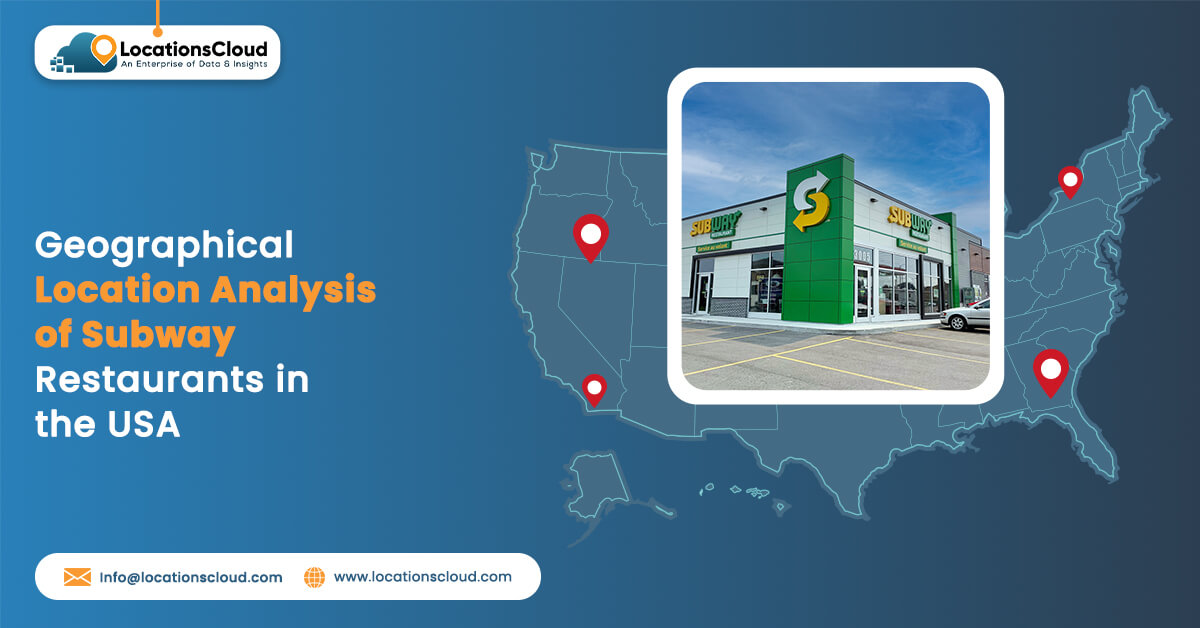
Subway is one of the most famous American fast-food restaurants. Its unique specialty is sub sandwiches, in addition to pizzas, salads, and cookies. The name ‘Subway’ is inspired by New York City Subway, and many of its restaurants have photos and maps of this wonder hanging in the restaurants.
Subway is an eatery outlet that deals with submarine sandwiches, which are Italian rolls that are split and then packed with sliced meat products, cheese, vegetables, and sauce. It operates out of Milford, Connecticut, and has a presence in over 37000 franchise establishments across nearly 100 countries. It was bought from its private equity firm Roark Capital in 2024 for $9.
Quick History
In December 1984, the first Subway location outside of North America opened in Bahrain. Since then, it has grown fast, and today, Subway has opened more than 44,000 outlets and is present in over 112 countries. This vast global coverage thereby makes Subway the largest fast food restaurant chain in terms of the total number of outlets, and this eats deeply into McDonald’s market share despite the latter having a way better sales figure.
Since 2007, US Subway has been on Entrepreneur Magazine’s list of the best 500 franchises and cited as one of the fastest-growing franchises. Furthermore, in the same year, in March precisely, Subway received another recognition: Amplicate.com is the most loved fast food chain in the United States, which speaks to the already established product dominance in America.
Subway currently has an international division, presiding over its global operations from Shelton, Connecticut, USA, and with the assistance of five regional offices worldwide. European franchises are controlled from Amsterdam in the Netherlands, while Australia and New Zealand franchises are controlled from Brisbane, Australia. This area is supported by offices located in Beirut, Lebanon, and Singapore, while the Miami office in the USA supports the Latin American market. It also has a highly decentralized organizational structure, which enables the effective management of Subway’s franchising business across different international markets.
Competitor Analysis
Catering to the consumer fast-food culture of America, Subway is one of the most prominent fast-food franchises, existing across 54 states and territories and in numerous cities. Subway joints are more than Starbucks in terms of outlets, with Subway having 20,603 outlets in about 52 states and 3,663 cities, while Starbucks has 16,621 outlets. Starbucks is famous for its coffee and cookies, whereas Subway has a broader coverage of eating joints, and it can reach more people with its sandwiches and salads. An outline of McDonald’s performance reveals that this competitor has 13,529 stores in the same number of states and cities as Subway but in 5,045 cities only, which still cannot compete with the former’s density.
Other chain competitors are backwardly differing in coverage, namely Hunt Brothers Pizza, Dunkin’ Donuts, and 7-Eleven convenience stores. Hunt Brothers Pizza currently has 9,703 outlets in 36 states and 4356 cities, mainly in convenience stores instead of free-standing restaurants. Currently, the company has Dunkin’ Donuts Stores in 45 states of the United States and 3,281 cities. This is comparatively smaller than the chain of subways, and the company serves mainly coffee and baked products. On the same note, the target market of 7-Eleven, with a store distribution of 9402 outlets in 38 states and 2365 cities, primarily is a convenience store. It can be said that Subway, owning a large number of restaurants, is one of the leaders in the fast food market, which offers a wide choice of easily accessible meals for numerous and various customers all over the United States of America.
How Many Subway Restaurants Are There In The United States?
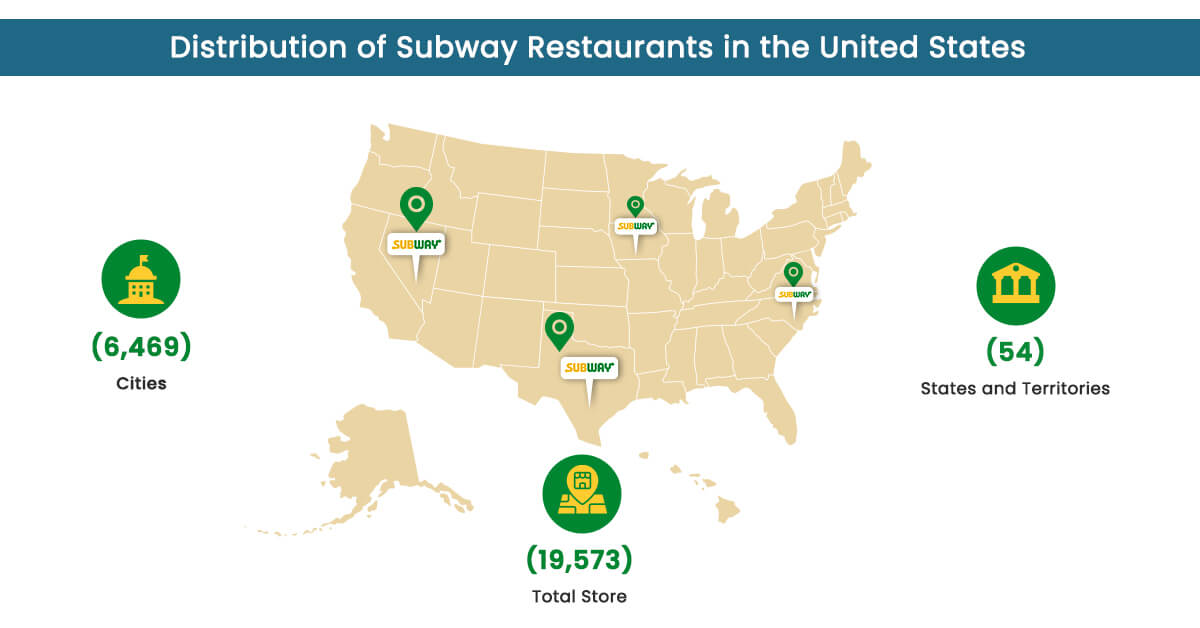
Our organization is expansive by occupying 19,573 unique location types and thus can be deemed large-scale. This widespread connectivity spans 54 states and territories, suggesting a diverse geographical and population integration. Also, being present in 6,469 cities, it urges the message that the product is readily available and accessible. These areas of specialization, coupled with the vast outreach, show that the proposed Institute shall be able to provide services for and expand service delivery to several communities. Every site located in the middle of the metropolis and spacious territory proves the commitment to serving as many people as possible, offering services and essential items distribution.
This comprises about 11% of all Subway premises in the United States of America. For years, Houston, Texas, has hosted the most Subway stores, a record that still stands today with 196 stores. This figure means that a sample of Subway shop franchises is less than one percent of the total Subway stores in the United States of America.
States and Territories with the Most Subway Restaurants
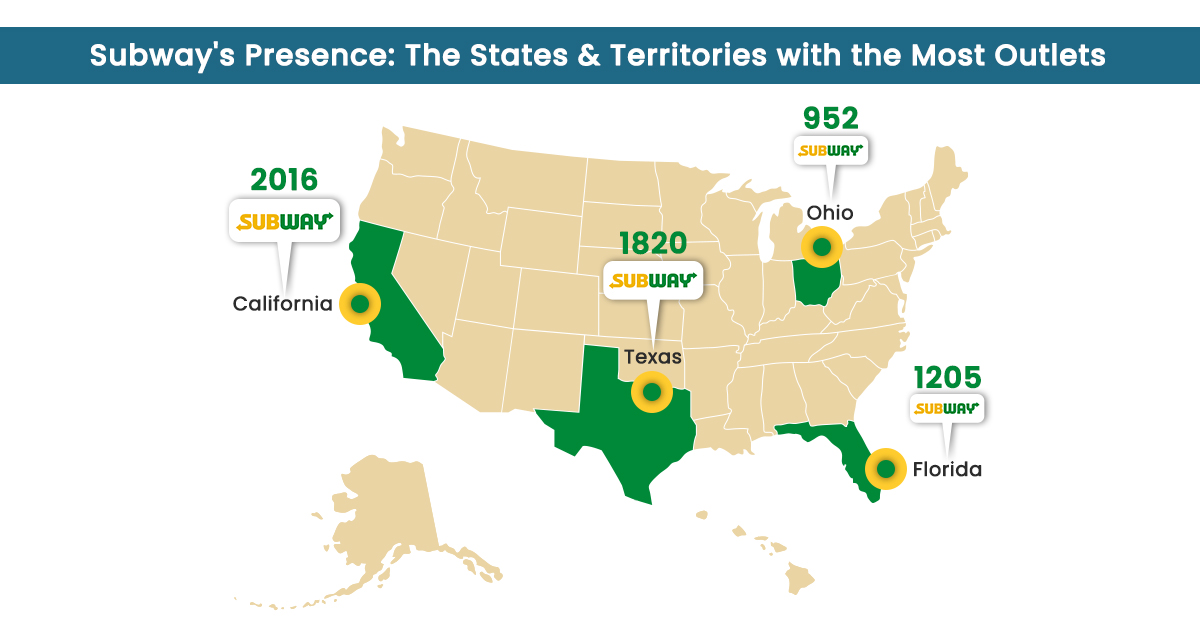
There are subway restaurants or stores in 54 states and territories in the US, which indicates that subway restaurants among fast food chains are accessible almost anywhere in the country. The subway has outlets in nearly all locations and can satisfy different markets, including urban people and suburban dwellers. Subway stores are numerous, which means that consumers of the food chain in almost every part of the United States can get their normalized sandwiches, wraps, and salads.
The figures presented indicate that Subway is a genuinely American chain that is beloved in different states of the country.
California has total 2,016 Subway outlets, which is about 11 percent of all the Subway restaurants, the state boasts the highest presence of Subway dining facilities in the United States. This translates to 54 Subway stores per one million people and derives to one store per 18,672 residents. The almost double concentration of Subway outlets in California compared to other states in America demonstrates the large substantial market for affordable, fast food relative to the high density of a significant and large population.
Texas slightly falls behind with 1820 Subway outlets, which is a close percentage of the national total Subway restaurants of 10. 69 Subway stores serve one million people in Texas, and as such, the distribution of facilities is one store for every 14,449 residents. Florida is the third state with most Subway outlets in the country, with 1,287 locations and a market share of 7%. This number is equivalent to 65 stores per one million people in the state, i.e. one outlet per approximately 16,690 residents. Florida’s high number of stores is a definite sign of its higher population and its long standing position as fast food eateries that are not only consumed by tourists but are also found in mixed-ethnic neighborhoods.
Florida has 1205 subway restaurant locations which makes the state one of the most popular states known to host this fast-food franchise. This large number of Subways means that anyone from the residents to the visitors of the state can enjoy a sandwich and/or salad that can be tailored to his/her preference. Due to Florida’s population, tourism, and therefore the necessary supply of fast food restaurants, the number of these stores is indeed rather large.
Ohio has 952 Subway fast food restaurants, which means it has 5% of all the franchise locations across the USA. With 87 stores per each of the 1 million population, Ohio has one store for only 11,551 people. The numerous eateries in the state of Ohio mean strong market competition in the populous state, which is satisfied by the many consumers who prefer to consume food quickly and at a low cost.
These statistics indicate the extent of penetration by this chain in these states, affirming the easy accessibility of Subway eating joints by populations within these regions.
List of Other States and Territories With Most Subway Restaurants
In addition to the top states with the most restaurants, several additional states and territories exhibit a notable presence of the restaurant brand Subway.
With 917 locations nationwide, Illinois has 4% of all Subway restaurants. With a population of 12.67 million, there are around 64 Subway locations per million people or one station for every 15,565 people.
With 766 locations, New York accounts for 4% of all Subway locations in the United States. With 19.45 million people, there are around 41 Subway restaurants per million or one station for every 24,435 people.
Michigan has 749 Subway outlets, accounting for 3% of the total. With 9.99 million persons, there is one Subway for every 14,888 people living in Michigan, or around 67 Subway locations per million citizens.
There are 708 Subway locations in Georgia, which is about 3% of the total number nationwide. With 10.62 million residents, there are around 60 Subway restaurants per million or one location for every 16,698 residents.
Three percent of all Subways in the United States are located in North Carolina, where there are 680 locations. With 10.49 million people, there are around 57 Subway locations per million or one Subway for every 17,483 people.
Pennsylvania also has 631 Subway outlets, which accounts for 3% of the total nationwide. With 12.80 million persons, there are around 52 Subway restaurants per million or one location for every 19,076 people.
These numbers demonstrate how widely distributed and easily accessible Subway restaurants are in different states, which indicates the brand’s broad appeal.
Cities with The Most Number of Subway Restaurants in the USA
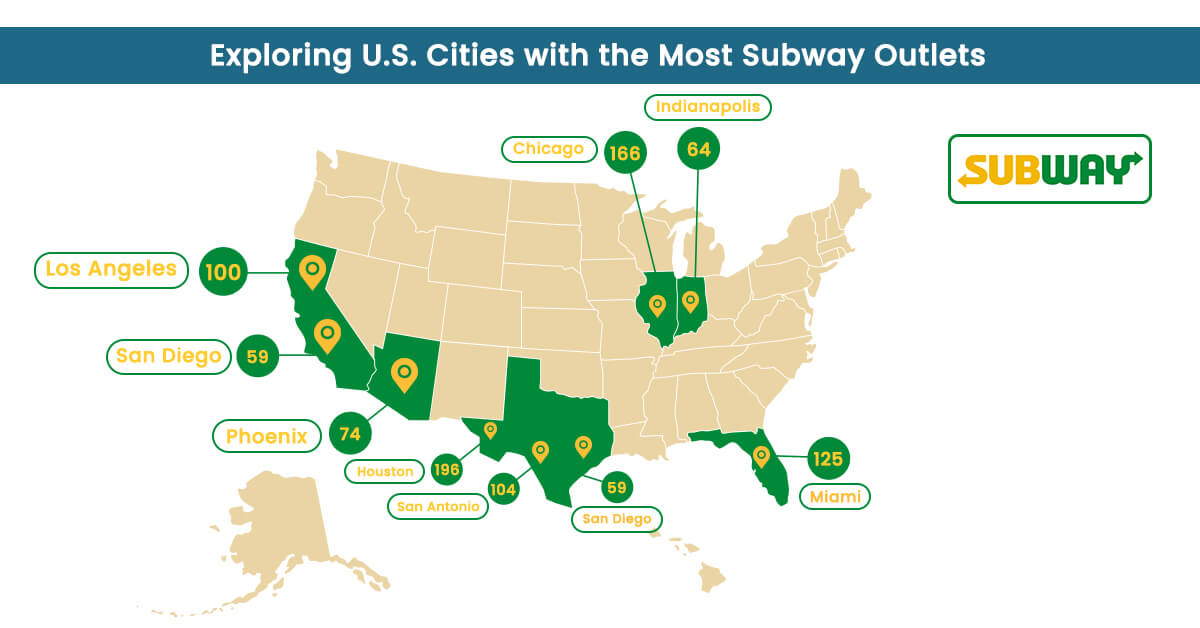
Some cities in the United States are notorious for having many Subway restaurants because it is one of the most famous franchises. Specifically, the town with the most Subways is Houston, Texas, with 196 locations. This large number of restaurants is enough for the city’s adequately large population and people’s diverse demand for various food types.
Chicago, Illinois, is in second place with 166 Subway outlets. Lively in its population and built-up density, Subways are prevalent all over Chicago, providing an excellent opportunity for a quick bite to eat. Subway is also well-represented in Miami, Florida, with 125 outlets. The city’s lively and active lifestyle and the never-ending stream of tourists or businessmen ensure that fast, convenient, and personal meals like Subway are always in demand.
San Antonio, Texas, has 104 subways, illustrating that this fast-food chain has promising dominance in this fast-rising city. Likewise, Los Angeles, California, has 100 stores, a high population density, and tourists demand healthy fast foods. The entertainment and tourism capital of the world, Las VegSubway restaurants. This guarantees that members of the community and the many tourists who visit the area each year will not have a problem locating a Subway to grab a bite of food.
Phoenix and Dallas each have 74 units, which shows that Subway has a good market share in these giant cities. Indianapolis, Indiana, has 64 stores, another example of the significant market demand for Subway. Last on the list is the city of San Diego in California, which has 59 Subway outlets to serve the city’s population and those who are conscious of their diet.
It shows the chosen locations where numerous Subway restaurants exist. It proves that this chain focuses on the growth in demand for quickly prepared, fresh, and convenient food in urban environments.
States and Territories Without Any Subway Restaurants
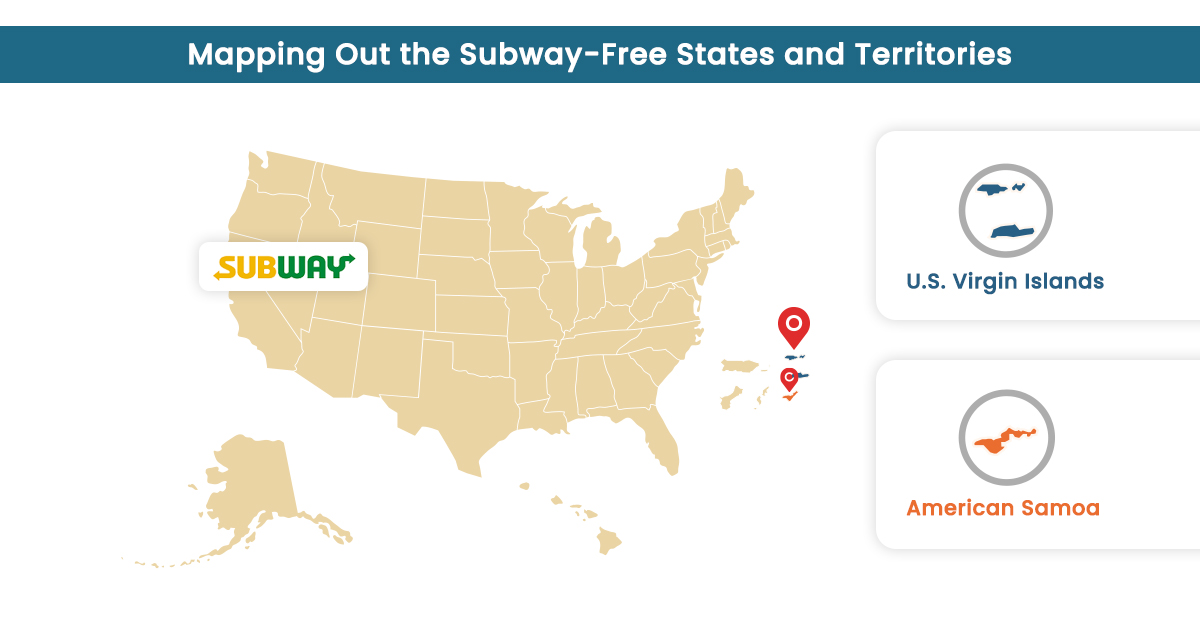
In the United States, there are only two places where you won’t find any Subway restaurants.
As a territory of the United States, American Samoa has the highest risk of achieving the current target by 2014 compared to other territories, especially the U.S. Virgin Islands. American Samoa is an island in the South Pacific region, while the U.S. Virgin Islands is in the Caribbean region. However, these two territories are exempted from having any Subway restaurants even though Subway is one of the fast food franchises with many stores in the United States of America and other parts of the world. This is rather unconventional because Subway can be observed as being present in most areas of the world; however, due to factors such as markets, distribution, and customer tastes, both American Samoa and the U. S. Virgin Islands have no Subway outlets.
Conclusion
Subway Restaurants are growing in the United States through franchising, outlet diversification, and menu development. Due to the flexible and decentralized organization based on the franchise concept, the number of stores controlled by the corporation has increased rapidly. Subways can be found practically in every country. This has also helped Subway to set up outlets in various environments, such as the central business districts, the outskirts, and even different parts of the country. The brand also targets unusual places like airports, colleges, and convenience stores, as it is essential for the brand to service its clients under different circumstances. Also, new menu varieties are added at Subway, health concerns, customizable sandwiches, and regional menu ideas that may be added at Subway to suit the consumer’s taste and preference.
In this respect, Subway spends money on advertising and sponsorships that increase brand awareness and encourage potential franchisees to join the company. Pest also focuses on digital business. As a part of the digital transformation, the company has adopted online ordering, delivery, and mobile applications to promote client communication. Subway, therefore, implements the above strategies to not only achieve the goal of expanding physical space but also enrich customers’ touch points on the brand. Such a diverse development strategy guarantees that Subway is still a viable and readily available fast food restaurant for consumers across the United States, thus fueling growth and profitability in the promising market.


